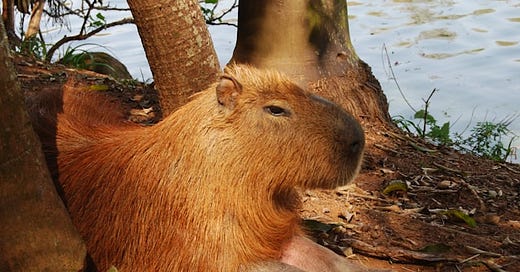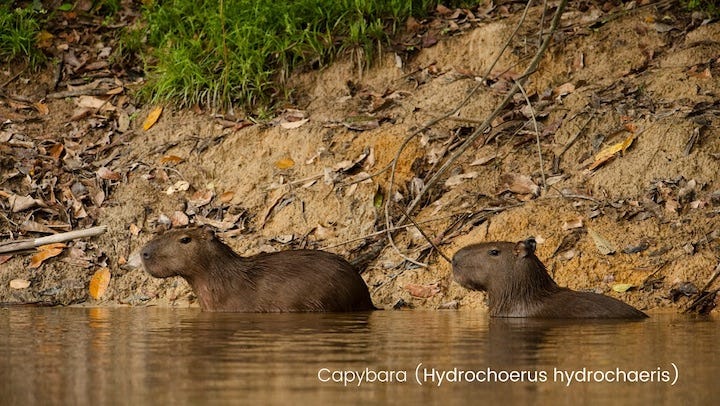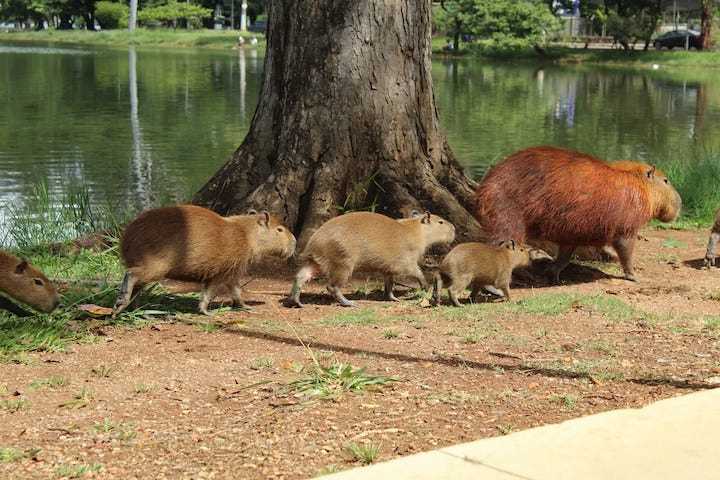Capybara Privilege:
rodent, fish, mammal, shit-eater, meme icon, spirit animal - and lessons for us all.
In early January I had a dream in which two animals of the same breed featured: a small version and a larger, more regal version. In the dream itself, I knew the animal was a CAPYBARA, even though in my waking state, I had to google “capybara” to see whether the images captured the likeness of the animal in my dream. It seems my dream-soul got it right, and the creature was indeed a capybara - an animal of which I knew very little. So down the google rabbit-hole I scuttled, to research this cutie!
In the google rabbit-hole, I learned that the capybara wears many hats:
rodent,
fish,
mammal,
shit-eater,
meme icon of highly social being,
spirit animal
It turns out that the capybara is (per National Geographic website) actually the largest known rodent (so, a mammal), having an average lifespan of up to 7 years in the wild. They can grow 4.6 feet long: up to 2 feet high at shoulders, and can weigh in at close to 150 lbs.1 That is one scary rat!
As a general rule of zoology, rodents are not *ALSO* fish. But the noble capybara spends a good portion of its life in the water. This water-dwelling is equipped by small eyes, noses, and hairless ears located high on their heads so that their faces remain exposed and alert when most of their body is submerged. Apparantly, all this time spent in the water imparts to the capybara flesh a “fishy flavour” (hold the jokes until the end please).
Legend has it that, sometime between the 16th and 18th centuries, the Vatican declared the capybara a fish, at the behest of missionaries who wrote, asking whether it might be eaten during Lent, given that it tasted like fish. The church2 deemed the capybara a fish, and they have been consumed during Lent ever since, in South America.
I say “Legend has it”, because, although this story is cited in numerous articles, I could not find a reliable historical article pertaining to the Vatican on this matter. But, when I read this legend, it did remind me of the Doctrine of Discovery, which, unfortunately, is no legend.
“The Doctrine of Discovery was set out in a series of declarations by popes in the 15th century. These declarations (known as “papal bulls”) provided religious authority for Christian empires to invade and subjugate non‐Christian lands, peoples and sovereign nations, impose Christianity on these populations, and claim their resources. These papal bulls were written at a time when European empires were embarking on widescale colonial expansion.”3
I do find the legend of the capybara being declared a fish to be believable. Why?
Because if the Vatican saw fit to declare religious authority (as we know it did) for Christian conquest and subjugation of non-Christian lands, well, claiming zoological authority doesn’t seem like too far of a stretch to me.
Our behaviours in big arenas like claiming lands for ourselves may perhaps be used to draw conclusions about how we may claim zoological classifications too.
Humans. Savages.
Capybara. Fish.
Being considered a fish, for the sake of Lent, might be thought of by some to be a privilege. Fish are more highly favoured in general as food-kind than rodents. But this truly is a matter of perspective along the lines of “baddie-and-the-mouse”.
You see, when I was a teenager, our household inherited a cat named “Baddie” from some neighbours who migrated from Jamaica. We, the Bandara family, were always a dog household. But Baddie joined our family and walked the corridor of our home, meowing loudly when she wanted us to wake up and feed her. She had free reign of indoors and outdoors, and often kept my father company on the verandah, where he liked to work (and smoke) until all wee hours of night and morning.
When I first moved to Canada, my father (whom I called “Thathi”, Sinhalese for father) and I wrote to each other a lot: hand written posted letters, as well as email. In one of those letters (the handwritten ones), Thathi told the tale of a half-dead mouse brought to him on the verandah by Baddie.
He said she played with it, tossing it about until eventually it died.
He wrote eloquently about how, from the perspective of the cat, this was a game, but from the perspective of the mouse, this was life-and-death. I read from that letter at his funeral, as I remembered his ability to see how perspectival life truly is.
How much of life today similarly is perspectival:
policies of immigration and border control, politics and high level economics to some, are matters of life and death to others.
claims of God-given land-rights to some, are matters of colonization, forced displacement and invasion for others.
diversity, equity and inclusion policies, necessary for some to even be considered, seen as unfair and disposable by others.
glasses that are half-full to some, are glasses that are half-empty to others.
The privilege of being called a fish would have meant death to many a capybara, as it made its way from waterway to Lenten dinner plate. From the capybara’s perspective, do you think they would have seen that as a privilege?
As a mammal, the capybara has been researched extensively, for some evolutionary features that may benefit human medical practice. I confess, I didn’t understand all the scientific language of it all, but a few articles identified that the same evolutionary development in capybara which allowed them to grow to such size without succumbing to cancer, may help human beings understand how immunotherapy could be used to fight cancer.4
So far: rodent, fish, mammal … and next up the adorable feature of auto-coprophagy 5- or eating their own poo! Yup, the adorable capybara eat their own poo, usually for breakfast as the first meal of the day. This (not uncommon in the animal kingdom) behaviour allows them to digest the things they may not have been able to quite digest the first time around.
Now, we could stand to learn a lot from this: metaphorically speaking. A lot of what slams us from the news feeds is absolutely mind-boggling, and makes us want to turn away.
Looking feels harmful.
Digesting, even more-so.
But is it possible for us to understand actions that, at first glance, are completely reprehensible to us? Is it possible for us to look at the needs behind the reprehensible-at-first-glance actions? And, perhaps a more important question:
Without at least some level of understanding,
without comprehending,
how can we possibly imagine apprehending the reprehensible?
In my own observations, most reprehensible behaviours stem from fear, and/or a desire for power. Neither the fear not the desire for power can be dismantled without spending some time to examine the mechanics of what is at play. In the world we find ourselves in today, multiplying our energies of anger, frustration and fear in our conversations does not equip comprehending or apprehending.
The wise capybara, in its desire to gain all it can from what it eats, quite literally eats it twice. The second time, it’s a shit-eating experience. But, through that process, all the necessary nutrients are apprehended.
In the past two weeks alone, I have heard at least a half-dozen stories of families and relationships being torn by opposing views on the politics of Donald Trump. It is really hard to hold space for different perspectives. It is hard to not rush to a place of being offended, and pushing the other away.
This reminds me of the way COVID vaxxing positions tore families apart. Finding middle ground somewhere, finding ways to talk, to listen, to hear, to be heard - these are vital tools in the survival of our species at this time. We have to learn how to occupy spaces together.
How to occupy countries together.
How to occupy continents together.
This is something the capybara has learnt to do really well - earning it a place in modern meme culture, as a symbol of peace, sociability, adaptability, and balance. Unbeknownst to me, I even benefitted from this meme culture, as my niece Darshini gave me a Christmas gift which included capybara merch (which I only recognized after my dream and research!!)
This symbolism in meme culture emerges from the many spirit animal associations which the capybara holds in traditional indigenous Tupi and other South American tribes.
“In many indigenous cultures, the capybara is revered not only for its physical attributes but also for its spiritual symbolism. For instance, in some South American tribes, the capybara represents a totem of water and earth, symbolizing the fluid balance between emotional depth and practical grounding.
These cultures hold ceremonies and tell stories where the capybara plays a pivotal role in teaching the young about respect for nature and the interconnectedness of all living things. Its presence in folklore and myth underscores its importance as a symbol of harmony, community, and the natural cycles of life.” 6
Whether we consider the capybara to be privileged in its classification as a fish, or privileged as a creature who can teach us ways to be better as societies, I think the capybara’s story holds lessons for us all.
We occupy a world in which we must co-exist, a world in which there is room for all, and many ways of looking at things. Honouring values of harmony, community, adaptability and balance are all lessons we can take from this fishy rodent!
photo credits:
1st photo - regal Capybara - Photo by michelly alves on Unsplash
2nd photo - pair of Capybara in water - from Facebook Intercaribbean Airways
3rd photo - Capybara family - Photo by Erick Martins on Unsplash
https://www.nationalgeographic.com/animals/mammals/facts/cabybara-facts
https://www.foodandwine.com/news/capybara-beaver-muskrat-lent-approved-foods
https://humanrights.ca/story/doctrine-discovery
National Geographic Online, Sept 28, 2018, By Carrie Arnold “World's Largest Rodent Has Surprising New Way of Fighting Cancer” & https://www.biorxiv.org/content/10.1101/424606v1
Auto-coprophagy - https://kids.guinnessworldrecords.com/news/2024/5/do-capybaras-eat-their-own-poo-more-fun-facts-about-the-worlds-largest-rodents-768309
https://www.capybaranation.com/post/capybara-spiritual-meaning-is-the-capybara-your-spirit-animal







Very interesting. I was aware of the existence of capybara as a species, but was totally unaware of much of what you wrote. Lots to think about - and not just about the capybara as one of God's creatures.
Thought provoking Janaki. I knew about the capybara, but you added a great deal to my knowledge. It seems that humanity continues to fall into unhealthy practices. Look to the capybara (along with many of God's creatures) and see what we need to learn.